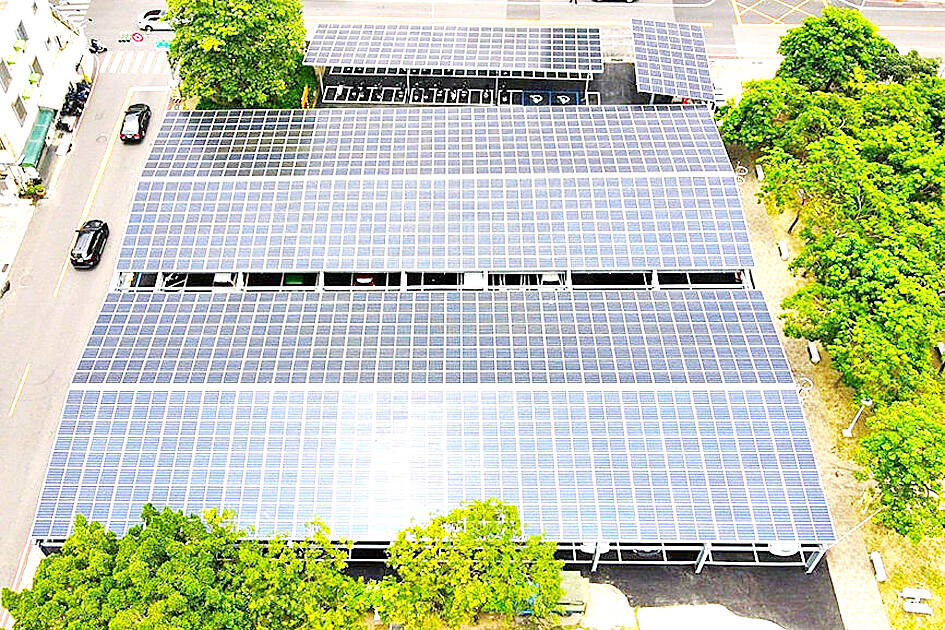Power generated from solar and wind made up nearly one-third of the nation’s energy mix at noon yesterday, setting a record, Taiwan Power Co (Taipower, 台電) said.
Electricity generated from solar and wind totaled 7 gigawatts, accounting for 31.53 percent of the power generated at the time, surpassing the 31.21 percent recorded on Jan. 25 and setting an all-time high, the state-owned utility said.
Taipower credited fair weather conditions for the milestone.

Photo courtesy of Tainan Bureau of Transportation via CNA
Taiwan also hit a separate milestone in green energy transition, after solar and wind sources had generated more than 15 percent of the nation’s electricity for seven days in a row as of Monday, Taipower said.
The government has set the goal of reducing its dependence on “gray” electricity and boosting green power generation to 15 percent of the nation’s energy mix by 2025, down from its original goal of 20 percent.
In December last year, the nation generated more electricity from solar and wind power than coal for the first time, with gas power taking the lead, Taipower data showed.
The increase in green energy generation and the decline in coal power indicate that green energy is replacing “gray” electricity in the nation, Taipower said.
Gas remains the nation’s largest power source, generating about 33 percent of its energy on Monday noon, Taipower data showed.
The growth in renewable power generation could also be linked to more solar panels and wind turbines being installed in Taiwan, the utility said.
Last year, solar panels with a combined capacity of 2.5 gigawatts were installed on rooftops and fish ponds, Taipower said.
Offshore wind turbines with a combined capacity of more than 1 gigawatt were also erected, the company added.
Last year, 20.08 billion kilowatt-hours of electricity were generated by solar and wind, amounting to about 8 percent to all power generated, Taipower said.
With new solar and wind power plants coming online, the Ministry of Economic Affairs expects the renewable sources to produce an additional 2 gigawatts of electricity this year, which would be equal to the power generated by two nuclear reactors.
Household energy users and businesses have voiced concerns about possible power shortages as the nation changes its power mix.
Deputy Minister of Economic Affairs Tseng Wen-sheng (曾文生), who is acting chairman of Taipower, said he does not expect the retirement of a nuclear power plant to cause a shortage in the power supply, as increases in renewable energy would offset the impact.
Tseng made the remarks during a Femora TV interview on Sunday in response to concerns about the planned retirement this month of a reactor at the Guosheng Nuclear Power Plant in New Taipei City’s Wanli District (萬里).

CHIP RACE: Three years of overbroad export controls drove foreign competitors to pursue their own AI chips, and ‘cost US taxpayers billions of dollars,’ Nvidia said China has figured out the US strategy for allowing it to buy Nvidia Corp’s H200s and is rejecting the artificial intelligence (AI) chip in favor of domestically developed semiconductors, White House AI adviser David Sacks said, citing news reports. US President Donald Trump on Monday said that he would allow shipments of Nvidia’s H200 chips to China, part of an administration effort backed by Sacks to challenge Chinese tech champions such as Huawei Technologies Co (華為) by bringing US competition to their home market. On Friday, Sacks signaled that he was uncertain about whether that approach would work. “They’re rejecting our chips,” Sacks

NATIONAL SECURITY: Intel’s testing of ACM tools despite US government control ‘highlights egregious gaps in US technology protection policies,’ a former official said Chipmaker Intel Corp has tested chipmaking tools this year from a toolmaker with deep roots in China and two overseas units that were targeted by US sanctions, according to two sources with direct knowledge of the matter. Intel, which fended off calls for its CEO’s resignation from US President Donald Trump in August over his alleged ties to China, got the tools from ACM Research Inc, a Fremont, California-based producer of chipmaking equipment. Two of ACM’s units, based in Shanghai and South Korea, were among a number of firms barred last year from receiving US technology over claims they have

BARRIERS: Gudeng’s chairman said it was unlikely that the US could replicate Taiwan’s science parks in Arizona, given its strict immigration policies and cultural differences Gudeng Precision Industrial Co (家登), which supplies wafer pods to the world’s major semiconductor firms, yesterday said it is in no rush to set up production in the US due to high costs. The company supplies its customers through a warehouse in Arizona jointly operated by TSS Holdings Ltd (德鑫控股), a joint holding of Gudeng and 17 Taiwanese firms in the semiconductor supply chain, including specialty plastic compounds producer Nytex Composites Co (耐特) and automated material handling system supplier Symtek Automation Asia Co (迅得). While the company has long been exploring the feasibility of setting up production in the US to address

OPTION: Uber said it could provide higher pay for batch trips, if incentives for batching is not removed entirely, as the latter would force it to pass on the costs to consumers Uber Technologies Inc yesterday warned that proposed restrictions on batching orders and minimum wages could prompt a NT$20 delivery fee increase in Taiwan, as lower efficiency would drive up costs. Uber CEO Dara Khosrowshahi made the remarks yesterday during his visit to Taiwan. He is on a multileg trip to the region, which includes stops in South Korea and Japan. His visit coincided the release last month of the Ministry of Labor’s draft bill on the delivery sector, which aims to safeguard delivery workers’ rights and improve their welfare. The ministry set the minimum pay for local food delivery drivers at